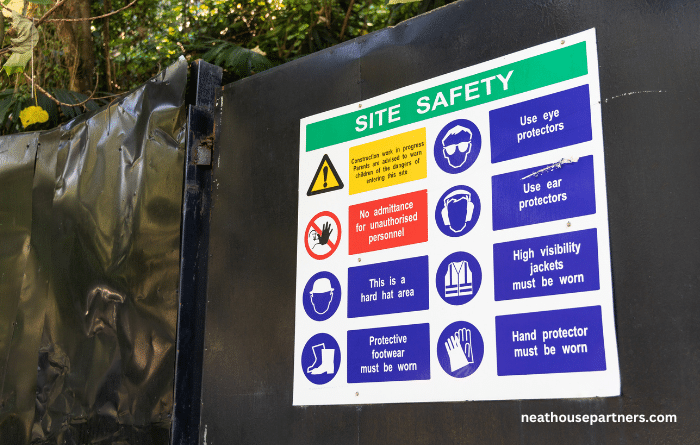As a UK employer, providing proper safety signage in your workplace is a legal requirement that brings important benefits. Failure to follow safety signage regulations can put your business at risk of fines, tribunals, and accidents.
Stay on top of H&S with our fixed-fee service
This article will overview the key regulations and best practices you need to know to maintain compliant, effective safety signage.
Who Needs to Follow Safety Signage Regulations?
The Health and Safety (Safety Signs and Signals) Regulations 1996 apply to all employers, duty holders, and anyone in charge of work sites and premises where people are employed.
This includes offices, factories, construction sites, and other work environments.
Why Do Clear Safety Signs Matter?
Safety signs serve the vital purpose of quickly warning employees and visitors of hazards, mandatory actions, prohibitions, and emergency information.
Without effective signage, your employees may be unaware of risks like slippery floors, flammable materials, protective equipment requirements, and emergency exits. This puts them at risk of injury or even death.
Clear, consistent safety signage helps you fulfil your legal duty of care to provide a safe working environment. It also protects your business from reputational damage and lawsuits that can result from accidents.
What Are the Rules on Workplace Safety Signage?
The Health and Safety (Safety Signs and Signals) Regulations 1996 require you to:
- Provide safety signs where risks can’t be avoided/controlled through other means
- Maintain signs to keep them legible and visible
- Explain any unfamiliar signs to employees
- Follow the BS EN ISO 7010 standard on shapes and colours
- Position signs appropriately for visibility
- Use signs to identify prohibited actions, mandatory actions, warnings, and emergency information
The standardised colour/shape meanings are:
- Red circle: Prohibition signs
- Red rectangle: Fire safety signs
- Yellow triangle: Warning signs
- Blue circle: Mandatory action signs
- Green rectangle: Emergency escape or first aid signs
Consequences of Non-Compliance
Failure to follow safety signage regulations puts your business at risk of:
- Fines – The HSE can take legal enforcement action for non-compliance. Fines can be up to £20,000 per offence.
- Lawsuits – If an accident occurs that could have been prevented with proper signage, you may be sued for negligence and compensation claims.
- Reputational damage – Accidents due to poor safety practices negatively impact your company’s reputation.
Tips for Compliant, Effective Safety Signage
Follow these best practices when implementing and maintaining safety signs:
- Conduct risk assessments to determine where signage is needed.
- Ensure signs are made from durable, high-quality materials suited to the environment.
- Check positioning and visibility – signs should be clearly seen and understood.
- Provide training to employees on the meaning of signs.
- Customize signs with workplace-specific instructions when useful.
- Illuminate fire safety signs and exits to ensure visibility.
- Regularly inspect and maintain signs to keep them clean, visible, and compliant.
Recording Your Safety Signage
Documenting the safety signs used throughout your workplace is an important part of maintaining compliance.
You should have a record of:
- Where each safety sign is located
- The type of sign and message displayed
- When the sign was installed and last inspected
- Any maintenance or replacements done
This allows you to monitor your safety signage usage and ensure signs remain visible and appropriate over time. It also demonstrates due diligence in case of HSE inspections or accidents.
Consider creating a safety signage register or logbook listing sign locations, installation dates, inspection dates, and maintenance notes. Safety managers should regularly review and update it.
Training Staff on Safety Signs
While many safety signs are universal, you should still train staff on their meanings and required actions.
Include safety signage training as part of your overall health and safety induction program.
Focus training on:
- The meanings of coloured shapes (red triangle, blue circle etc)
- Any workplace-specific signs employees need to know
- Required actions when seeing certain signs (e.g. wearing PPE)
- Location of emergency and first aid signs
Retrain staff when new signs are introduced or signage schemes change. Also, include signage understanding as part of refresher health and safety training.
Signage for Visitors and Contractors
If your workplace has visitors or contractors, also consider their understanding of your safety signs.
For unfamiliar visitors, provide an orientation explaining sign meanings and emergency procedures indicated. Don’t assume they will intuitively understand.
For regular contractors, include a safety signage overview as part of their site induction. Focus on signs relevant to their work areas and risks.
Having clear signage that’s understood by all personnel helps maintain a consistently safe workplace.
Sign Design and Placement for Visibility
Carefully consider design factors like size, text, placement, and illumination to maximize visibility:
- Large format signs are easier to see at a distance.
- Sans serif fonts provide better legibility.
- Place at eye level, avoiding obstructions.
- Use brackets, posts, or walls suitable for the sign material.
- Illuminate where needed, especially fire safety signs.
- Take glare and reflections into account near windows or lamps.
- Place signs at access points to prohibited areas.
- Use supplementary text for extra instructions.
With smart design and positioning, your signs will be noticed and understood.
Protect Your Business with Proper Safety Signs
Ensuring compliant safety signage is a legal requirement for UK employers. It also provides vital protection and communication for your employees.
Follow the regulations and best practices outlined here to maintain a safe, legally compliant workplace.
At Neathouse Partners, our health and safety consultants can provide guidance on implementing effective safety signage tailored to your business.
Contact us today to discuss your specific requirements.








